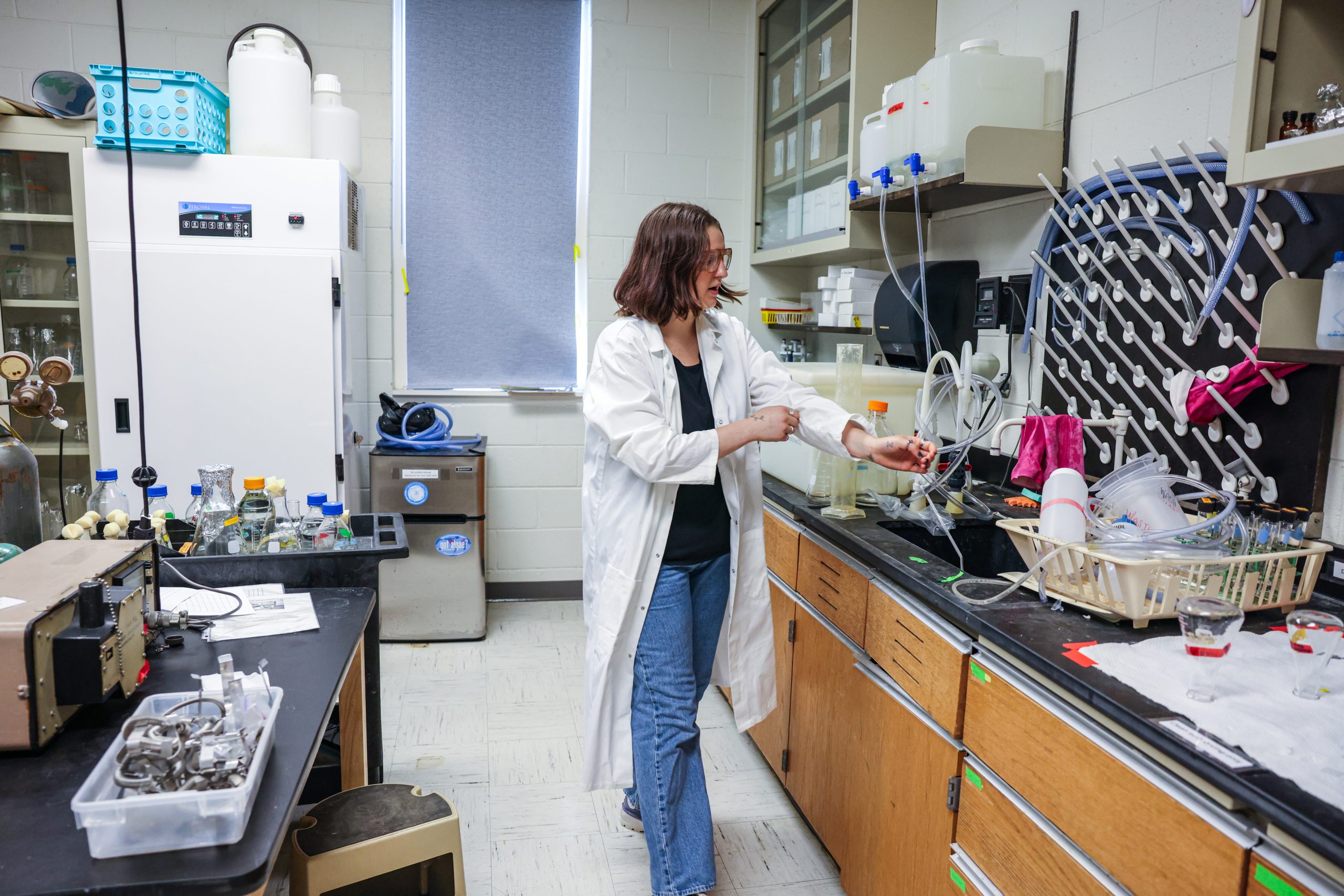
So much for saving the planet. Climate careers, and many others, evaporate for class of 2025
Grace Veenstra has spent her life marveling at the volcanoes, glaciers and forests in her native Alaska.
As a student at the University of Alaska Fairbanks, she worked for an institute that monitors ice floes, fires and other activity on the state’s vast landscape with satellites operated by the federal National Oceanic and Atmospheric Administration. Then on a NOAA scholarship last summer, she interned with scientists who study fish ecosystems and decided she wanted to work for the agency.
“This is a great agency for me,” Veenstra, 21, recalled thinking. “They’re interested in climate studies and understanding natural hazards.”
As she was beginning to look for jobs ahead of her graduation this May, Donald Trump took office and cut NOAA’s workforce by 20 percent. The Commerce Department, which runs NOAA, accused a grantee of promoting “climate anxiety,” and the Trump administration is trying to eliminate NOAA’s research arm and cut a quarter of its budget. Climate has become a dirty word in Washington.


“I’ve stopped looking at anything related to NOAA,” Veenstra said. “It would have been a great place to work, but it’s like, I don’t know if I couldfind a job. If I could find a job, I don’t know if I could keepthe job.”
As the class of 2025 enters the workforce, the Trump administration has dismantled career pathways for graduates interested in climate and sustainability work, international aid, public service and research across the natural, behavioral and social sciences. Federal jobs are disappearing, and the administration is eliminating grants and agency divisions that sustain university research programs and nonprofits that are crucial to launching careers.
The National Science Foundation, for example, halved graduate research fellowships, canceled some undergraduate research grants, stopped awarding new grants, froze funding for existing ones, and eliminated several hundred grants for focusing on diversity, equity and inclusion. In March, Robert F. Kennedy Jr. announced 10,000 layoffs at his agency, the Department of Health and Human Services; earlier buyouts and firings had already cut another 10,000 jobs.
In addition, the Trump administration effectively dissolved the U.S. Agency for International Development and the Institute of Education Sciences. The administration fired more than 1,200 Department of Energy workers in February, and the Environmental Protection Agency has faced deep cuts too, while its administrator reconsiders a key finding that underpins much of its work.

Data on the immediate effects of federal policy shifts on employment are scarce, but numbers from the National Association of Colleges and Employers (NACE) show a nationwide pullback. In February and March, employers projected a 0.6 percent increase in hiring, a drop from their fall 2024 projection of 7.3 percent. Employers projected a small dip in internships this year.
Graduates who have spent the last four years or longer preparing to serve people or save the planet are discouraged and wondering: How bad is the job market? Should I switch fields? Buy time in grad school, in a discipline Trump hasn’t touched? Find something abroad?
Ellie Wilmarth, a 2025 graduate who researched algae throughout her time at St. Mary’s College of Maryland, was wait-listed for a doctorate program in oceanography. A professor there told her that funding to support graduate students would likely dry up this fall. Another program accepted Wilmarth, but it wasn’t a good fit, so she’s plunging into the job market.
“All of the people in my field are getting fired right now,” she said. “So how do I find a job?”
Related: Become a lifelong learner. Subscribe to our free weekly newsletter featuring the most important stories in education.
“How do I get a job?” is a question that had been getting somewhat easier to answer for many students, thanks to a strong economy and a growing emphasis on connecting education to careers. “A majority of students have had career prep experiences: internships, summer research experiences, shadowing,” said Marjorie Hass, president of the Council of Independent Colleges.
NACE data says these experiential learners have higher career satisfaction and earn $15,000 more per year than those without that experience. Christine Routzahn, director of the University of Maryland, Baltimore County’s career center, said that surveys over the last few years consistently show that six months after graduation, half of employed students landed jobs at the organizations where they had interned.

In other words, students know what to do before hitting the job fairs senior year. But this winter and spring, at least along the Interstate 95 corridor north of Washington, job fairs looked a little different. At an April 9 “industry fair” in UMBC’s sunlit Commons, one table stood empty: The U.S. Equal Employment Opportunity Commission, scheduled to attend, didn’t make it. At Bowie State University, sustainability and energy coordinator Jabari Walker organized a “climate career expo” in February. Thirty employers attended, Walker said, but five federal employers “had to pull out shortly after the new administration took office.” At a March 31 Montgomery College job fair targeting recently fired federal scientists, Odalys Hernandez, a representative for science and technology company MilliporeSigma, saw hundreds of people with doctorates looking for work.
“I definitely worry about the students because they’re being faced with a whole wave of new competition,” Hernandez said.
Related: For new grads, landing a job may be hard. Navigating the workplace may be harder
Undergraduates who pursue research and internships develop faculty connections, but now when students approach professors for guidance, they find even more uncertainty.
“We are dealing with so many moving targets at the same time,” said Dana Fisher, who directs the Center for Environment, Community and Equity at American University in Washington, D.C., and is a professor in its School of International Service. Fisher says that academia writ large has no consensus on what guidance to offer students right now.
“I’ve actually had several professors tell me at this point to stay in grad school as long as humanly possible,” said Jaida Rhea, who graduated from Goucher College in Baltimore this spring after two years on an NOAA scholarship.
But Deanna Knighton, a trustee at the National Career Development Association, which provides resources for practitioners inside and outside of academia, cautions against rushing into graduate school, and not just because of the financial cost. She got two master’s degrees: one straight out of undergrad and one three years later. “It was just so much more valuable to go after I had worked for a year or two,” Knighton said.
“All our professors are saying we should pivot for the next few years,” said Natalie Mulimbi, who just finished a master’s program in international relations and public administration at Syracuse University. Mulimbi, 26, delayed her graduation date to move to Washington, D.C., and intern at the U.S. Agency for International Development through its federal Pathways program, created through an executive order by President Barack Obama to recruit talent for the civil service. She started at the end of November. Less than two months into her internship, the Trump administration gutted USAID, and Mulimbi found herself on a pathway to nowhere.
“It’s just not realistic to look into international work right now,” she said, so she is looking for jobs in Washington, D.C. She hopes her background doing social work and fundraising can help her find work at a nonprofit, but she worries about the loss of funding across that sector. On the advice of a professor, she is researching internships on Capitol Hill, hoping she’ll find something related to international policy.
“It’s tough right now,” she continued, saying the chaos is affecting the relationships and finances of friends whose Washington experiences were cut short. “I think it’s taken a toll on a lot of people’s mental health.”
Related: College leaders refocus attention on their students’ top priority: Jobs after graduation
While the Trump cuts are likely to hamper many members of the class of 2025, they will hit hardest for students like Mulimbi and Veenstra, who have put their career eggs in the “make the world a better place” basket.
“The cuts and the larger attacks on the legitimacy of the nonprofit sector could potentially have really severe effects on employment in that sector, obviously,” said Chelsea Newhouse, who co-authored a recent report on nonprofit employment. But it’s tricky to gauge how severe. The U.S. Bureau of Labor Statistics releases nonprofit-specific data only every five years. The Chronicle of Philanthropy built a tracker for nonprofit layoffs — counting 14,430 from January to April — but Newhouse said it is likely a “big undercount.”
“Goat farming knows quarterly what’s happening with their employment,” Newhouse said. “We really have to fly blind on nonprofit employment most of the time.”

Any retrenchment will likely have the biggest impact on graduates who are not white. In their fervor to crush diversity, equity and inclusion initiatives, Trump administration officials have cut specific pipelines for students from underrepresented racial and ethnic groups. NOAA canceled this year’s award for the José E. Serrano Scholarship, which funds two years of study at minority serving institutions — after students had already applied.
Perhaps most unnerving to this graduating class is the question of “when.” When will the pathways to their passions open again?
“I’ve had a lot of people tell me, ‘Well, maybe they don’t need us now, but they’ll need us in four years,’” said Rhea, the Goucher graduate. “But the problem with telling a college graduate that is like, ‘No, I want to be needed now.’”
One suggestion Fisher, the American University professor, offers students in the meantime is working in state and municipal government. For those with the resources, she said, a master’s program could be a good way to ride this out for two years. And not necessarily in the United States.
“Getting graduate degrees is much cheaper in other countries,” Fisher said. “It’s terrible: I don’t really want to be telling people to leave the country. But, you know, it’s on everybody’s mind.”
It may be too early to worry about a “brain drain,” but the European Commission recently set aside $500 million to attract researchers.
“I’m now hearing stories of students seeing foreclosed opportunities here and taking talents elsewhere, which is tragic,” said Hass of the Council of Independent Colleges.
One student graduating from Vanderbilt University, who asked to remain anonymous because she worries speaking out will cause professional repercussions, plans to do just that. She studied education policy and child development, intending to get a doctorate in the U.S. and work as a pediatric neuropsychologist in New York City. With the prospect of funding for child development research looking so bleak here, she applied to programs in the United Kingdom.
She plans to stay there.
“I am queer, I am of color, and I don’t feel safe building a family in America,” she said. “In addition to that, with the education system and this kind of attack on the U.S. Department of Education, I don’t trust that there’s going to be a system in place where my children can thrive.”
For graduates who pivot here in the U.S., how many will retain their enthusiasm for their fields when they feel it’s possible to enter them again? And for those who do, will the door still be open for them?
“When and if the economy recovers, people will want to hire shiny, newly minted graduates, not people who have been out a few years in jobs that don’t take advantage of their best skills,” said Hass.
Several academics said they believe some students’ pivots will be driven by a desire to prevent a crisis like this from happening again. “Some students are using this as motivators to buckle down,” said Knighton of NACE. “You know, ‘I’m going to try to work in government or in law or public policy to turn these uncertainties right.’”
These last few months have changed Veenstra’s outlook. “I’m certainly not discounting the possibility” of working at NOAA, she said, “but I’m considering it with more hesitance.”
Veenstra sees people doing science “long into the future.” She’s just not sure how much science, or how many people it will serve.
“I don’t know what things are going to look like after this,” she said. “I plan to continue to work in the sciences. For myself and lots of others, we like what we do and we do it to help folks.”
Contact editor Caroline Preston at 212-870-8965, via Signal at CarolineP.83 or on email at preston@hechingerreport.org.
This story about climate change jobs was produced by The Hechinger Report, a nonprofit, independent news organization focused on inequality and innovation in education. Sign up for the Hechinger newsletter.
Source link



